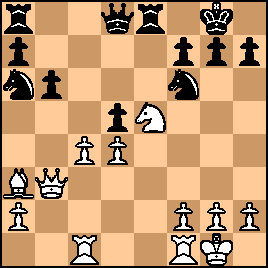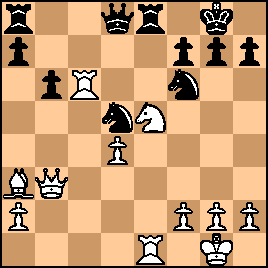| Apr-21-07 | | Whack8888: Does anyone see a winning line after 24...fxe5?
25. Qxe5+ Rg7 and I dont see really anything for White. The pawn is unprotected and the Queen can take it defending along the 7th rank so further attacking the pinned rook on g7 doesnt work and Black's back rank is as far as I can see also well guarded making Rc8 ideas useless. Perhaps after 24...fxe5 White should keep his Queen where it is and simply play Bb2--White has a pretty good attack, and Black's King is very open, but I dont see how White can win. Maybe the best looking for position White would be 25. Qxe5+ Rg7 26. Rd1 and Black doesnt have a whole lot of moves--both his rooks are stuck and his Queen is needed more or less where it is. I am moderately content that 26. Rd1 is the line that causes Gunsberg to play Rg5 instead of fxe5 but I would appreciate somebody else's input. |
|
| Apr-21-07 | | vonKrolock: 24...fe 25.♗b2, Δ ♗xe5 check, followed by ♕xa8 - there's no satisfactory defense against the threat |
|
Apr-21-07
 | | Phony Benoni: <Whack8888> After 24...fxe5, 25.Bb2 looks deadly to me. The threat is mate after 26.Qxe5+, and I don't see a defense. If 25...Qg5, then 26.Bxe5+ Rg7 27.Qxa8+ leads to mate. On 25...Rg5, 26.Bxe5+ Rg7 27.Qxa8 Qxa8 28.Rc8+ forces mate. That seems to leave moves of the h-pawn, but they don't help: 25...h5 26.Qxe5+ Kh7 27.Qxh5#, or 25...h6 26.Qxe5+ Kh7 27.Qf5+ Rg6 28.Qf7+ Rg7 29.Qxg7#. |
|
| Feb-28-08 | | Knight13: Black should've played ...c5 at move 5 or 6. That would've helped. |
|
| Sep-14-08 | | JimmyVermeer: Had Black not resigned, the game might have ended:
28 e6 Kg7 29 e7 Kf7 30 d8Q Rxd8 31 exd8Q Ke6 32 Qd6+ Kf7 33 Qe7+ Kg6 34 Bb2 Kg5 35 Qxf6+ Kh5 36 h3 b5 37 g4# |
|
| Nov-09-11 | | AnalyzeThis: White doesn't even need his bishop in the final position to win. |
|
| Jul-14-12 | | King.Arthur.Brazil: I guess that Gunsberg made 2 mistakes at the oppening: 1st: the QN had not developed so 7...b6 seems premature and turns White Square Diagonals weak. 2nd: the change of WSD Bishop didn't solve the problem, turn it worst. Steinitz showed in the 15'th move: all his pieces are full working and black has nothing then saw him explode the center and the poor BQN; expose BQ, BK and BQR to attack. Nice game! |
|
| Oct-06-13 | | Karpova: Steinitz plays the Queen's Gambit again!
A spectator: <“Well, Steinitz tires me by this.”> (1) After game 5 - Steinitz vs Gunsberg, 1890 - <Steinitz was heard to declare his intention of playing the same opening again on Monday when his turn comes, and in fact again and again until he wins it.> (2) Steinitz also explained <"“My memory is not so good as it was, and I cannot always, in a complicated position, rely on book knowledge."> but that he always tried to introduce opening novelties. (1) Sources:
(1) 'The Sun', New York, 1890.12.23
(2) 'The Sun', New York, 1890.12.19
Both from Jacques N. Pope's http://www.chessarch.com/archive/18... |
|
| Dec-31-13 | | Cooleyhigh: Steinitz was truly a Grandmaster ahead of his time. |
|
Sep-30-19
 | | An Englishman: Good Evening: Note to myself--never give Steinitz odds of Nb8 and Ra8 with the Black pieces. Also, challenge his pawn center with ...c7-c5 at the appropriate time, i.e., as soon as possible. Really like the move 20.Rd2!, which efficiently transfers that Rook to a vital file. |
|
| Sep-30-19 | | Momentum Man: Steinitz demonstrates a keen eye for tactics in this game, as you would expect from a world champion |
|
| Oct-19-19 | | thegoodanarchist: Anyway, this was MY PUN! That's right, peons!
I MADE THIS PUN! Muahahahahaha! |
|
Jun-09-24
 | | kingscrusher: Black could have really limited White's advantage it seems by 14...cxd4 to weaken the e5 knight support. Then after exd4 there is Na6
click for larger viewThis has the resource now of Nc5 which is very helpful for black. In the game, 14...Ne4 made black's situation far worse, and even worse after the f6 move later. |
|
| Jun-09-24 | | FM David H. Levin: <kingscrusher: Black could have really limited White's advantage it seems by 14...cxd4 to weaken the e5 knight support. Then after exd4 there is Na6
click for larger viewThis has the resource now of Nc5 which is very helpful for black.> I think Black would still suffer from his weaknesses at c6, d6, and f7 and
along the a3/f8 diagonal. An immediate 16.Nc6 doesn't seem to accomplish much after 16...Qd7 17.cxd5 Nxd5, so perhaps White's best is <16.Rfe1> to support his knight and the e7-square indirectly and possibly threaten 17.Nc6. Black still can't play 16...dxc4 owing to 17.Qxc4 with a fork, and 16...Rc8 would weaken the a7-square, so <16...Nc7> seems indicated. Then <17.cxd5 N(either)xd5 18.Rc6> 
click for larger view(or)

click for larger viewwould threaten to win material by 19.Rd6. That Black doesn't have a pawn at either c6 or e6 (to support the d5-square and to cloak some of his weaknesses) seems to give White more pressure than in most positions where he has an isolated pawn. |
|
Jun-10-24
 | | kingscrusher: <FM David H. Levin> Yes very difficult for black. I think maybe Black's major mistake was earlier with 9...Bxc3 - just handing a positional advantage to White on a plate :) |
|
| Jun-10-24 | | FM David H. Levin: <kingscrusher: <FM David H. Levin> Yes very difficult for black. I think maybe Black's major mistake was earlier with 9...Bxc3 - just handing a positional advantage to White on a plate :)> Indeed, I'm not sure why Black didn't try 9...Bd6, despite some dangerous-looking tactical possibilities for White. Rewinding from there, I hadn't recalled seeing 5...Bb4+. The "find similar games" link indicates that according to the CG database, this move has on average been played less than twice per decade (going back to the 19th century). It does seem less comfortable for Black than does the much more common 5...c5, but maybe this assessment of 5...Bb4+ would be different if I knew more about the theory underlying the move. |
|





